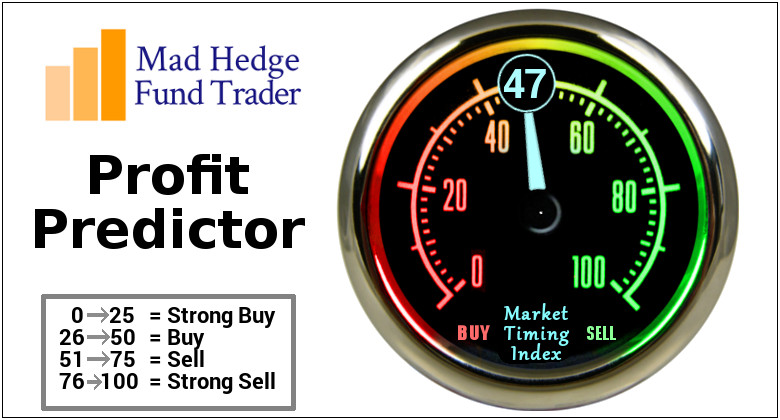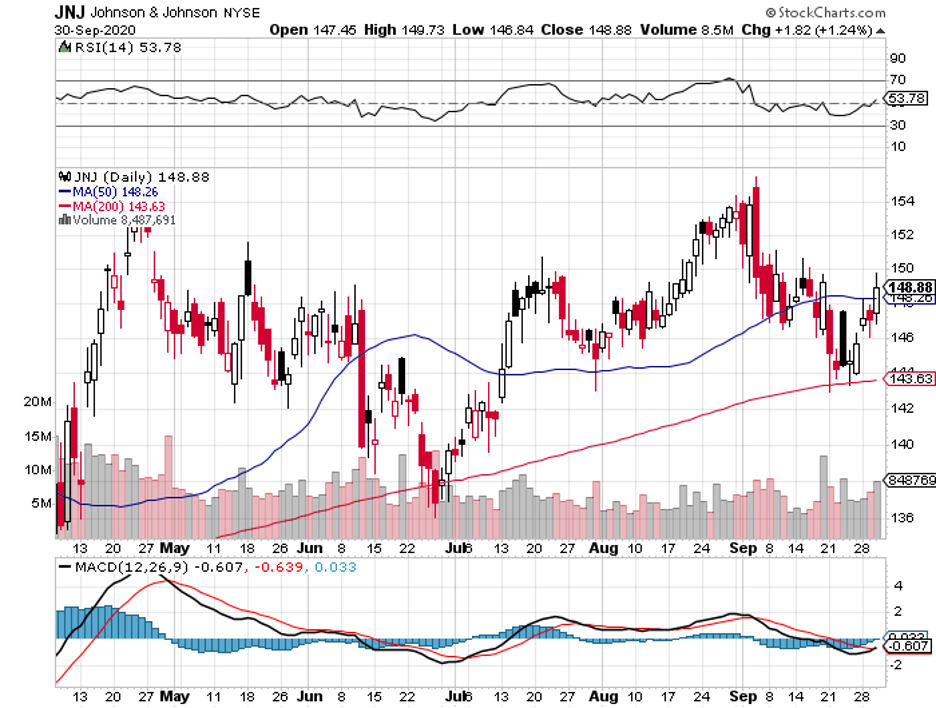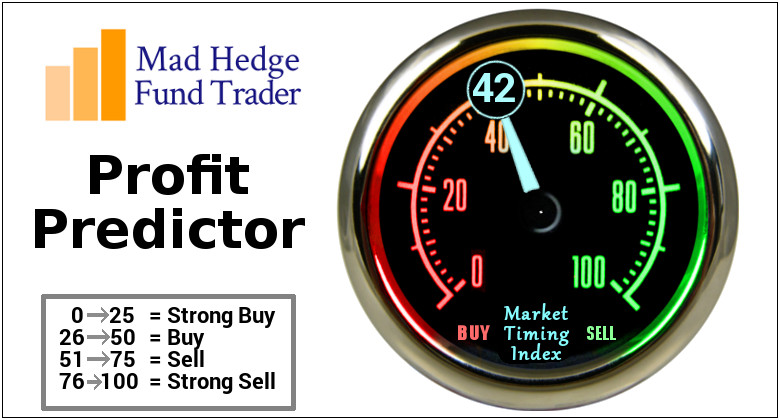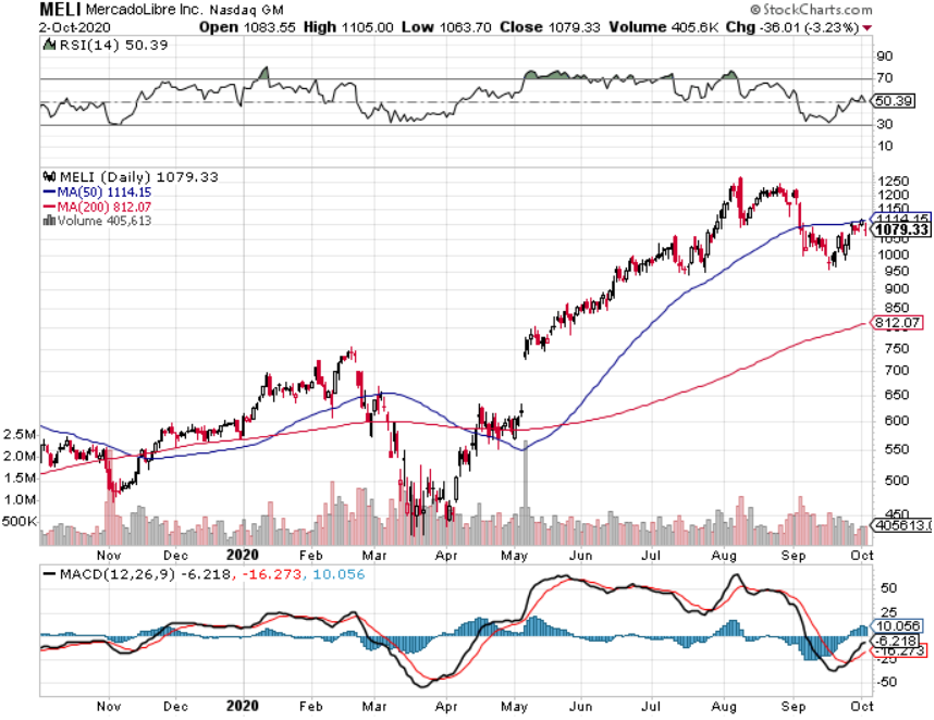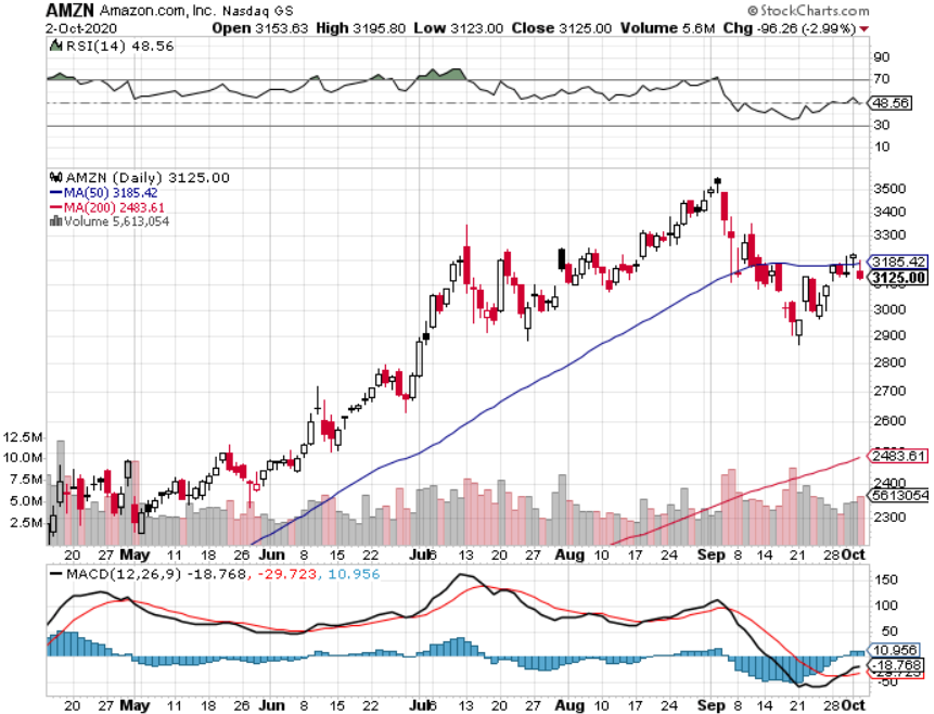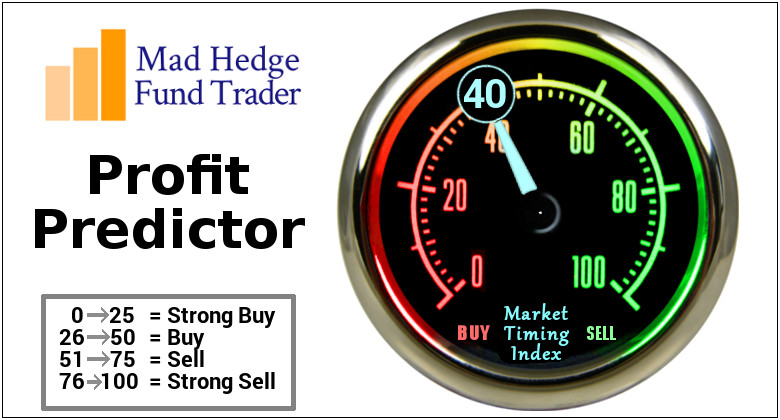In terms of the stock market, “A vaccine is more important than the stimulus,” said David Kostin, chief equity strategist at Goldman Sachs.
Mad Hedge Biotech & Healthcare Letter
October 6, 2020
Fiat Lux
FEATURED TRADE:
(CAN THIS DIVIDEND KING BE THE NEXT VACCINE KING?)
(JNJ), (MRNA), (PFE), (BNTX), (AZN), (INO), (NVAX), (SNY)
One area that Johnson & Johnson (JNJ) has not been a leader in for the past years is vaccine development.
That could change soon however.
Among the healthcare companies racing to develop a COVID-19 vaccine these days, JNJ has been a heavy favorite to come up with the most potent candidate.
Although the company started its clinical trials two months after Moderna (MRNA) and the partners Pfizer (PFE) and BioNTech (BNTX) started theirs, JNJ might release results even earlier than November.
This is because JNJ’s vaccine candidate, called Ad26.COV2.S, worked quickly on the patients after only a single dose.
In comparison, Moderna and Pfizer’s candidates need a first dose and then, after a month, a second dose or a booster shot.
While it could take a month or two for Moderna and Pfizer’s vaccines to take effect, those given Ad26.COV2.S could be protected after two weeks.
Moderna and Pfizer both use messenger-RNA technology for their vaccines, while JNJ utilizes a hollowed-out virus to deliver the DNA instructions to the relevant cells to trigger a protein spike and provoke an immune response.
This is the same method the company used in its Ebola vaccine, which has been instrumental in the immunization programs in Africa.
Inasmuch as Ad26.COV2.S offers incredible potency compared to other candidates, there is one potential trade-off: our immune system might later on start to resist the drug.
However, JNJ is attempting to resolve this issue by developing a booster shot for future use.
Meanwhile, Moderna and Pfizer’s vaccine candidates could be given as many times as possible without that risk.
JNJ’s vaccine can also be distributed and stored without any special handling unlike its rivals, which require lower temperatures. This means that the vaccine can be delivered to even the less-developed facilities.
Other than eliminating the logistical problem of people failing to get a second shot of the vaccine, JNJ’s one-shot regimen can guarantee that governments can vaccinate 1 billion people annually.
Only a handful of the manufacturers can match that claim, offering JNJ an edge regardless of the seven-month head start of the other developers.
Apart from JNJ, Pfizer, and Moderna, more companies have started their late-stage vaccine trials. The list includes AstraZeneca (AZN), Inovio Pharmaceuticals (INO), Novavax (NVAX), and Sanofi (SNY).
Outside its COVID-19 programs, JNJ has been delivering solid results despite the ongoing crisis.
The company’s pharmaceutical division showed notable growth in the second quarter, with its immunology drugs leading the charge.
In terms of sales in this quarter, rheumatoid arthritis and Crohn’s disease drug Remicade raked in $935 million while severe rheumatoid, psoriatic, and ankylosing spondylitis injection Simponi brought in $526 million.
Meanwhile, psoriasis medicines Stelara and Tremfya generated an impressive $1.7 billion and $342 million, respectively.
JNJ is also expanding its portfolio to cover the biotechnology market. So far, one of its most telling moves is its $6.5 billion all-cash acquisition of Momental Pharmaceuticals.
Buoyed by these promising results, JNJ boosted its full-year revenue guidance for 2020 with operational sales estimated to reach somewhere between $81 billion and $82.5 billion.
JNJ has been widely known for its consumer products, but the truth is that the company’s forte is actually healthcare.
In 2019, JNJ’s pharmaceutical sector comprised nearly 50% while medical devices generated roughly one-third of the company's total sales. These figures may very well be the reason why this stock is gaining traction among retirees.
After all, healthcare is where the money lies – and JNJ is now the biggest healthcare conglomerate in the world.
In fact, the company serves over 1 billion patients on a daily basis and 12 of the products in its portfolio can easily generate $2 billion in sales annually.
The company’s cash flows have also been steadily increasing, setting off an impressive 58-year streak of consistent and consecutive dividend boost every year.
Needless to say, JNJ has been hailed the “Dividend King” in the healthcare sector for decades now.
Simply looking at JNJ profile, track record, and pipeline, it’s clear to see that buying and holding JNJ shares and reinvesting the dividends you receive along the way could give your portfolio a substantial boost.
While the Diary of a Mad Hedge Fund Trader focuses on investment over a one week to a six-month time frame, Mad Day Trader, provided by Bill Davis, will exploit money-making opportunities over a brief ten minute to three-day window. It is ideally suited for day traders, but can also be used by long-term investors to improve market timing for entry and exit points. Read more
When John identifies a strategic exit point, he will send you an alert with specific trade information as to what security to sell, when to sell it, and at what price. Most often, it will be to TAKE PROFITS, but, on rare occasions, it will be to exercise a STOP LOSS at a predetermined price to adhere to strict risk management discipline. Read more
Mad Hedge Technology Letter
October 5, 2020
Fiat Lux
Featured Trade:
(THE AMAZON OF LATIN AMERICA)
(MELI), (AMZN), (ASML)
If you thought you missed profiting off of Amazon then you’re in luck; you still have another chance with the South American iteration of Amazon – MercadoLibre (MELI).
This e-commerce and payments platform in Latin America boasts presence in 18 countries within South and Central America but derives the bulk of its revenue from three countries: Brazil, Argentina, and Mexico.
MELI is the entrenched e-commerce player in the region and has multiple retailer solutions such as MercadoLibre Marketplace (an online platform for the buying and selling of merchandise), Mercado Pago (an online payments solution), and Mercado Envios (a logistics solution).
The company's market-leading position revolves around a strong network effect that has allowed it to expand its exploding user base as well as its gross merchandise volume (GMV).
In 2015, MELI had around 145 million registered users, and that number has more than tripled by 2020.
The tectonic shift toward digital transactions network caused by the pandemic means the number of items sold jumped 66% year over year to 284 million, and the number of unique active users climbed 27% year over year.
It’s undeniable that the company has strong tailwinds backing its overarching story.
MELI was already primed for a strong growth trajectory before the pandemic crushed the global economy.
The company was savvy in introducing new and useful services over the years to solve digital bottlenecks, and its suite of services made customers stickier toward its platform.
Hosting an integrated e-commerce and payments platform meant an unrelenting buildup of new vendors and users coming on board over time.
MELI looks set to take the next step in e-commerce penetration.
Although its growth has been phenomenal over the last decade, I believe the company may be on the cusp of doubling its growth rate because of the rapid digitalization by businesses.
A share repurchase program has been set in motion and I do believe they will dip into this financial tool once the global economy stabilizes.
Getting into the weeds, MELI expanded its category-take rates to Chile and Mexico in Q2 2020, with Brazil and Argentina set for last half of 2020.
For online marketplaces like what Amazon and eBay offer, the take rate refers to the fees and commissions that the companies collect on sales by third-party sellers which is critical to overall revenue.
The successful take rate rationalization could drive sellers to list more of their inventory and reduce prices.
With this increased supply, MELI should be seeing the cascading benefits of an improving shopping experience and rising conversion rates.
Scaling this beautifully translates to lower per-unit logistic costs such as sequential 23% decrease in unit shipping costs.
Ala Amazon, its drive to step up the buildout of its own logistics network to take down the dependency on Correios in Brazil is yielding meaningful results and also places the company to potentially buttress a greater amount of free shipping subsidies as the unit cost of deliveries continues to swan dive.
Logistics transforming into a higher reliability, faster shipping times, and greater cost savings offering can be passed along to the consumer upgrading the quality of service.
Soon, MELI is expected to invest in Consumer Electronics and price competitiveness could see the company grab market share taking down yet another adjacent industry.
At some point, like Amazon, MELI will target the grocery market and will have the logistic infrastructure in place to do the same type of 1-day “free” shipping that Amazon guarantees.
On the digital payments side of the business, MELI has sold over 1 million mobile point-of-sale (mPOS) devices, versus 900,000 during Q1 2020, driven primarily by smaller merchants.
The individual bull case for MELI is rock-solid but feeling out the global state of affairs is a must in a quickly changing environment.
With an onslaught of stimulus in Europe and the U.S. to deal with the pandemic, China’s economy beginning to recover, and a weaker dollar, foreign markets are becoming more attractive to U.S. investors.
Emerging markets could turn from stock market pariah to darling in a nanosecond and if investors are comfortable with targeting companies in higher growth markets, then MELI should be an option.
Emerging markets broadly have lagged behind developed market peers over the past decade, even as some fund managers have found investing in domestically-oriented companies in India, China, or Brazil hugely rewarding—just look at the outperformance by foreign brand names like Alibaba Group (BABA), Meituan Dianping and HDFC Bank (HDFC) in India just to name a few.
It’s true that more developed markets have the advantages of greater trading liquidity, minimal systemic risk, better corporate governance, and greater access to dollar-denominated debt that emerging markets’ companies don’t benefit from.
Therefore, investors seeking a conservatively biased portfolio should only focus on U.S. tech brand names that have moats around their business model.
Another second derivate play would be to find U.S. tech companies that siphon a big chunk of sales in emerging markets and are U.S. companies like Apple (AAPL), Nvidia (NVDA), and Mastercard (M).
Each secures between one-third and two-thirds of sales from emerging markets. But with those companies vulnerable to the geopolitical trip wire between the U.S. and China, proportioning a small amount of the portfolio to a Latin American tech growth firm could produce alpha.
Another quick recommendation is ASML, a semiconductor chip company from the Netherlands.
It’s an option generating outsized sales coming from emerging markets but is headquartered in an economically responsible country.
This Dutch tech firm boasts positive free cash flow yields, a sign the company is generating ample cash to operate and also reinvest in itself.
Investors who can stomach greater risk levels and desire growth should take a serious look at MELI, plus the myriad of other tech recommendations I offered if MELI doesn’t suit your appetite.
With the $6 call on CLVS expiring Friday, I would like to suggest you sell another round of calls for this week.
CLVS is trading around $5.82 as I write this.
And the $6 call that expires on Friday, October 9th can be sold for $.20.
I suggest you collect the 20 cents.
Here is the trade.
Sell to Open (1) October 9th - $6.00 Call for every 100 shares you own.
You should be able to sell them for $.20 for every option.
If the calls are assigned this Friday, the return will be about 12% in total.
This alert applies to you only if you are long the shares in CLVS.
While the Diary of a Mad Hedge Fund Trader focuses on investment over a one week to a six-month time frame, Mad Day Trader, provided by Bill Davis, will exploit money-making opportunities over a brief ten minute to three-day window. It is ideally suited for day traders, but can also be used by long-term investors to improve market timing for entry and exit points. Read more
Global Market Comments
October 5, 2020
Fiat Lux
Featured Trade:
(MARKET OUTLOOK FOR THE WEEK AHEAD, or IS HISTORY REPEATING ITSELF?)
(SPY), (INDU), (DIS), (TLT)
Legal Disclaimer
There is a very high degree of risk involved in trading. Past results are not indicative of future returns. MadHedgeFundTrader.com and all individuals affiliated with this site assume no responsibilities for your trading and investment results. The indicators, strategies, columns, articles and all other features are for educational purposes only and should not be construed as investment advice. Information for futures trading observations are obtained from sources believed to be reliable, but we do not warrant its completeness or accuracy, or warrant any results from the use of the information. Your use of the trading observations is entirely at your own risk and it is your sole responsibility to evaluate the accuracy, completeness and usefulness of the information. You must assess the risk of any trade with your broker and make your own independent decisions regarding any securities mentioned herein. Affiliates of MadHedgeFundTrader.com may have a position or effect transactions in the securities described herein (or options thereon) and/or otherwise employ trading strategies that may be consistent or inconsistent with the provided strategies.



